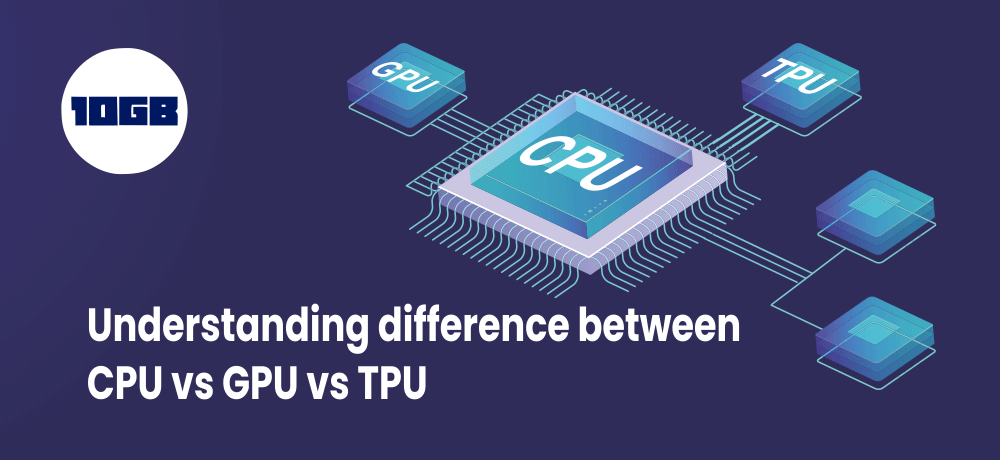In the current digital era, where technology is expanding exponentially, and Artificial Intelligence is becoming popular, the need for faster hardware is rising.
You may have heard about the computing processors; CPU, GPU, and TPU. But do you know the difference between CPU vs GPU vs TPU?
This blog post will discuss how the three processor units are distinct. So, let’s get started.
CPU vs GPU vs TPU : Overview of 3 Major Processor Units
In the early days of computing, the computer systems just had a CPU to perform arithmetic and logical operations; then, a few decades later, when the demand for parallel processing and video graphics rendering increased, GPU came into the scene and, now Google has designed application-specific integrated circuits (ASICs) to accelerate the machine learning workloads.
As we advance, here’s a brief comparison of CPU vs GPU vs TPU:
The difference between CPU, GPU, and TPU is that the CPU is the brain of any computer system and is responsible for performing and managing the computer’s logical, arithmetic, and I/O operations. On the other hand, a GPU is an additional processor capable of performing complex mathematical operations and advanced graphics rendering. Lastly, TPUs are Google’s custom-made powerful processors built specifically to work on its projects, i.e, TensorFlow. Of the three processor units, TPU is the most recent processor built to train and learn machine learning models faster.
Now, let’s get an in-depth understanding of the processing units CPU, TPU, and GPU.
What is a CPU?
Most of you might know about a CPU. Central Processing Units or CPU is deemed as brain of a computer. Like brain is vital for functioning of a human body, CPU is important part of the computing system.
As we said in the previous section, a CPU manages all the basic arithmetic, logical, controlling and input/output operations of a computer program. It is responsible for execution of the instructions for computer programs.
A CPU offers an environment to perform multiple task parallelly like connecting to the internet, displaying the desktop, handling graphical instructions while playing a game, etc.
Till early 2000s most of the computer systems consisted of just a single-core processor and in 2005, first dual-core CPU was introduced and now we can commonly see quad-core CPUs while a few prominent companies have introduced octa-core CPUs.
A few of the prominent CPU manufacturers are Intel, AMD, Qualcomm, NVIDIA, IBM, Samsung, Hewlett-Packard, VIA, etc.
What is a GPU?
GPU stands for Graphical Processing Unit. GPU was developed to manage high performing tasks such as graphics rendering which generally can’t be managed by the CPU. GPU reduces the load of a CPU by taking up task like high-end rendering and visualization task.
Due to its high data throughput and massive parallel processing, GPU is most commonly used in high-end gaming, data science, machine learning, bitcoin mining, etc.
A few of the prominent GPU manufacturers are NVIDIA, AMD, Broadcom Limited, etc.
What is a TPU?
TPU is the short form for Tensor Processing Unit. TPU is Google’s application-specific integrated circuit (ASIC) for deep learning and machine learning. Unlike other general processors like CPU and GPU, Google has developed matrix processor TPU for neural network workloads and machine learning for its TensorFlow software.
Though Google started using Tensor Processor Unit in 2015, they introduced it to the general public in 2018.
For those who don’t know, TensorFlow is an open-source library for machine learning and artificial intelligence. Tensor Flow has a comprehensive, flexible ecosystem of tools, libraries, and community resources that allows researchers to push the state-of-the-art in ML and offers developers the capability to build and deploy ML-powered applications effortlessly.
Through Google’s TensorFlow software, Machine Learning models can be deployed on Cloud, allowing one to easily access the ML model from a remote device.
Last but not the least, the operations which took hours to be done in CPU and GPU and TPU can do in minutes.
I hope this article on CPU vs GPU vs TPU helped you understand the difference between CPU vs GPU vs TPU.
Additionally, you can check out the Dedicated Server UK plan comprised of Intel Xeon D-1520, 32 GB DDR3 ECC, SoftRAID 4x2TBSATA, 1 IP Address, and 20TB Transfer at a competing price.

